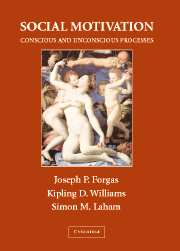Book contents
- Frontmatter
- Contents
- About the Editors
- List of Contributors
- Preface
- The Sydney Symposium of Social Psychology series
- 1 Social Motivation: Introduction and Overview
- PART I CONSCIOUS AND UNCONSCIOUS SOCIAL MOTIVATION: GENERAL ISSUES
- PART II SOCIAL MOTIVATION: COGNITIVE AND AFFECTIVE IMPLICATIONS
- PART III CONSCIOUS AND UNCONSCIOUS SOCIAL MOTIVATION: SOME CONSEQUENCES AND APPLICATIONS
- 14 Self-Regulatory Processes in Interracial Interactions: The Role of Internal and External Motivation to Respond without Prejudice
- 15 Exploring the Discrepancy Between Implicit and Explicit Prejudice: A Test of Aversive Racism Theory
- 16 Ostracism: When Competing Motivations Collide
- 17 Attentional and Regulatory Mechanisms of Momentary Work Motivation and Performance
- 18 Social Motivation and Object Relations: Narcissism and Interpersonal Self-Esteem Regulation
- 19 To Know or Not to Know: Consciousness, Meta-consciousness, and Motivation
- Author Index
- Subject Index
- References
17 - Attentional and Regulatory Mechanisms of Momentary Work Motivation and Performance
Published online by Cambridge University Press: 04 August 2010
- Frontmatter
- Contents
- About the Editors
- List of Contributors
- Preface
- The Sydney Symposium of Social Psychology series
- 1 Social Motivation: Introduction and Overview
- PART I CONSCIOUS AND UNCONSCIOUS SOCIAL MOTIVATION: GENERAL ISSUES
- PART II SOCIAL MOTIVATION: COGNITIVE AND AFFECTIVE IMPLICATIONS
- PART III CONSCIOUS AND UNCONSCIOUS SOCIAL MOTIVATION: SOME CONSEQUENCES AND APPLICATIONS
- 14 Self-Regulatory Processes in Interracial Interactions: The Role of Internal and External Motivation to Respond without Prejudice
- 15 Exploring the Discrepancy Between Implicit and Explicit Prejudice: A Test of Aversive Racism Theory
- 16 Ostracism: When Competing Motivations Collide
- 17 Attentional and Regulatory Mechanisms of Momentary Work Motivation and Performance
- 18 Social Motivation and Object Relations: Narcissism and Interpersonal Self-Esteem Regulation
- 19 To Know or Not to Know: Consciousness, Meta-consciousness, and Motivation
- Author Index
- Subject Index
- References
Summary
INTRODUCTION
The study of affect in work settings, and particularly the study of the performance implications of affective states, has a long but especially disappointing history. We say disappointing for a number of reasons. First, even the smallest amount of reflection will convince anyone that organizations are settings of emotional intensity. If emotions are generated by appraisals of the reaching or impeding of important personal goals or values, then where is this more likely to play out than in work settings? Each day at work, our needs, desires, and identities are challenged and affirmed. So, one would think that the study of emotions at work would be a core topic of organizational research. It is not. Second, performance has been the criterion of interest for organizational researchers. So, one would think that the relationship between emotional states and work performance would receive great attention. It has not.
Third, research on the performance implications of true affective states took place at the beginning of work psychology. Hersey (1932) examined daily moods states (he didn't call them that, but he used what today would be considered a mood checklist) among blue-collar workers. He tracked those mood states with daily performance measures. He showed that on negative mood days performance deteriorated quite a bit, but on positive mood days there was little enhancement of performance.
- Type
- Chapter
- Information
- Social MotivationConscious and Unconscious Processes, pp. 314 - 331Publisher: Cambridge University PressPrint publication year: 2004
References
- 7
- Cited by



